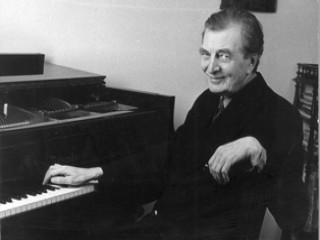
Alexander Tcherepnin biography
Date of birth : 1899-01-21
Date of death : 1977-09-29
Birthplace : St. Petersburg, Russia
Nationality : Russian-French
Category : Famous Figures
Last modified : 2010-11-19
Credited as : Composer of ballets, operas and instrumental music,
Alexander (Nikolayevich) Tcherepnin (1899-1977) was a Russian-French and later American composer of ballets, operas, and instrumental music.
Alexander Tcherepnin was born on January 21, 1899, in St. Petersburg, Russia. Descended from a family of musicians, Alexander benefitted from the experience of his father, Nikolay Tcherepnin (1873-1945), a conductor and composer who studied with Rimsky-Korsakov. The family house in St. Petersburg was a place where many well-known musicians and artists liked to meet. In this privileged atmosphere, the gifts of Alexander Tcherepnin were confirmed at an early age. At 14 he had already written an opera, a ballet, and several pieces for piano. In 1918 the family moved to Tbilisi, where Alexander continued his studies at the music conservatory. At the same time he gave concerts as both pianist and conductor.
In 1921 the political situation forced the family to leave Russia. They settled in Paris, where Alexander completed his studies with Paul Vidal (composition) and Isidor Philipp (piano). Later he became the co-founder of L'Ecole de Paris with Bohuslav Martinů, Conrad Beck, and Marcel Mihalovici, a group of foreign composers close to the neoclassical movement, although at the same time very interested in the music of their respective homelands. He made his Western début in London (1922), and a year later his ballet Ajanta's Frescoes, written for Pavlova, was performed at Covent Garden.
Although he began a professional tour of America in 1926, it was in 1927 in Paris that he suddenly attained fame after the premiere of his first symphony, which was a succès de scandale. (An entire section of the work is performed exclusively by percussion instruments.) Between 1934 and 1937 he travelled in several Far-Eastern countries. He taught in Tokyo, where he settled down for a while and founded a music publishing corporation to promote the works of his pupils. It was in Shanghai that he met the pianist Lee Hsien Ming, whom he married a few years later. Returning to France in 1938, Alexander Tcherepnin was unfortunately forced to limit his activities during World War II.
In 1948 he returned to the United States to teach at De Paul University, Chicago, becoming an American citizen in 1958. From 1964 to his death in 1977 he divided his time between Paris and New York. An invitation from the Soviet government in 1967 allowed him to tour his native country extensively.
A highly cosmopolitan figure, Alexander Tcherepnin moved easily from St. Petersburg to Paris and New York. Even before World War II some of his compositions revealed the influence of the Far East. His intense intellectual and musical curiosity found expression in compositions which can best be described as eclectic. As early as 1913 the Pièces sans titre op. 7 for piano contain examples of bitonality. During his stay in Paris (1921-1950), his compositions show the impact of the French esthetic (simplicity of textures, clarity of melodic lines), at the time vigorously demonstrated by the members of the Groupe des Six (Darius Milhaud, Germaine Tailleferre, Georges Auric, Louis Durey, Arthur Honegger, and Francis Poulenc). In addition, he used the percussive rhythm that Prokofiev preferred in his music. Russian and Georgian music appear in Rhapsodie Géorgienne for orchestra (1922) and Suite Géorgienne for piano and strings (1938).
Apart from those diverse outside influences, he experimented with his own new techniques of counterpoint and of rhythm. The French composer Alexandre Tansman (born in Poland) remembered that Tcherepnin in Paris notated the rhythmic flow of the sound of people reading a newspaper. In addition to those experiments, Tcherepnin used his own melodic scale of nine notes in most of his compositions.
It was in the United States that Alexander Tcherepnin coordinated the best elements of his research. Although he avoided using serial elements, he did not hesitate to use electronic techniques (see The Story of Ivan The Fool, commissioned by the British Broadcasting Corporation [BBC] in 1968). His works include several ballets and operas (Die Hochzeit der Sobeide op. 45, story from Hofmannsthal, 1930; The Farmer and the Nymphe op. 72, 1952). In his chamber music, Alexander Tcherepnin often wrote for unusual instrumental combinations (see Sonata da Chiesa op. 101 for viola da gamba and organ, 1966, and Caprices Diatoniques for Celtic harp, 1973), thus revealing his particular interest in musical timbre.
This cosmopolitan composer reflected in his music the variety of cultures in which he had resided.
W. Reich, Alexander Tcherepnin (Bonn, 1959, rev. 1970) provides insights on the man and his work.
















